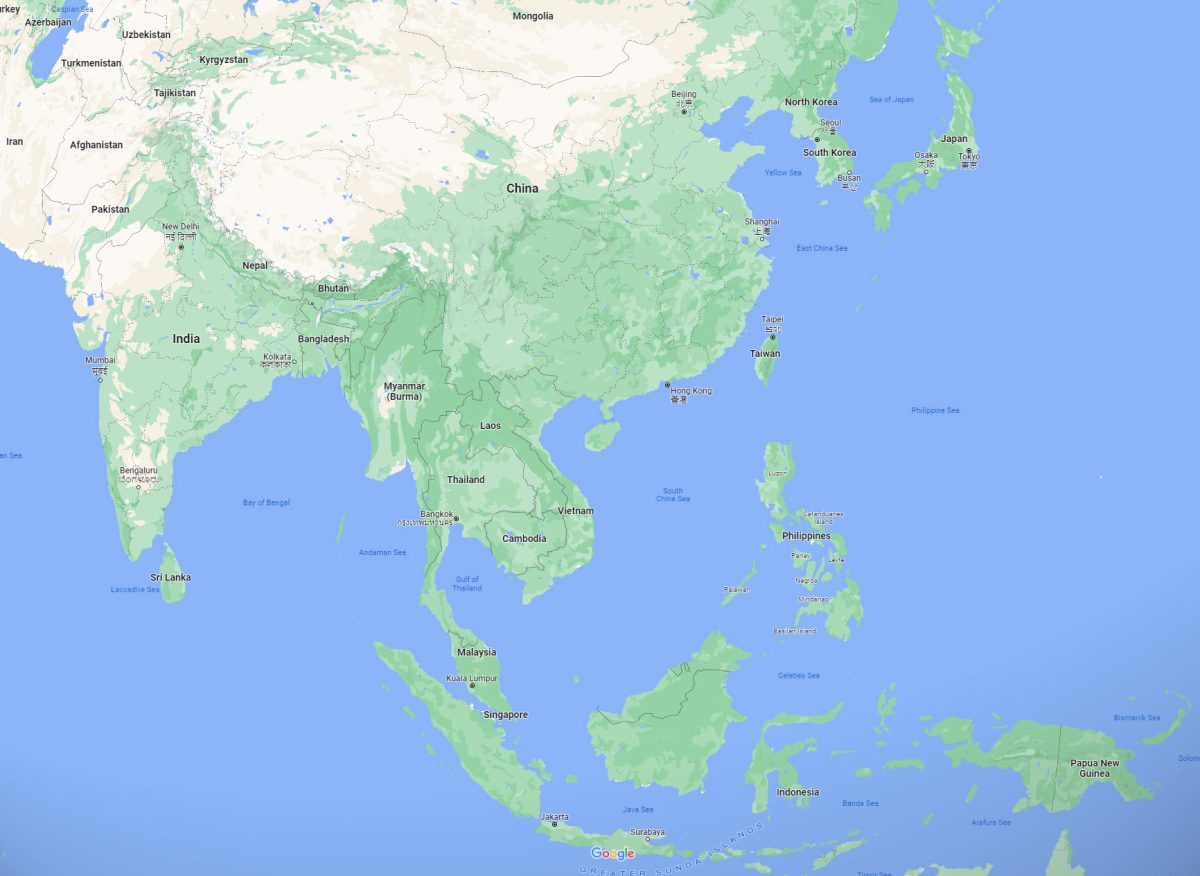EcoProcura China 2018: Summary and Highlights
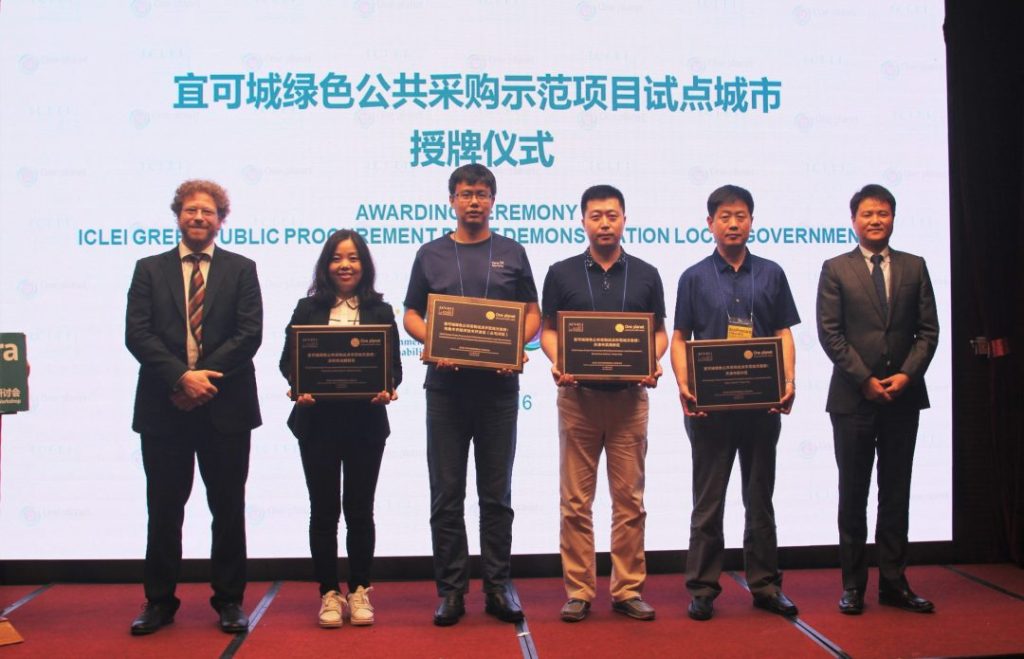
Jointly organized by the Beijing Environmental Protection Bureau and ICLEI East Asia, the EcoProcura China 2018 was held in Beijing, China on 16-17 May 2018 to provide comprehensive knowledge and advanced practices of green public procurement for Chinese local governments. On this occasion, ICLEI East Asia also launched the Procura+ East Asia network, which will serve the interests of local governments in the region to accelerate green procurement.
In supporting Chinese local governments to explore the possibilities of Green Public Procurement (GPP) implementation through knowledge exchange, developing strategies, and learn from global advanced practices, the EcoProcura China 2018: ICLEI Green Public Procurement Capacity Building Workshop was jointly held by the Beijing Environmental Protection Bureau and ICLEI East Asia, with support of the China Environmental United Certification Center (CEC) and the APEC Network on Green Supply Chain Tianjin Pilot Center (TGCC).
Gathering 31 representatives and officials from 11 Chinese local governments and global experts, the two-day workshop also marked the first event co-hosted by the Beijing Environmental Protection Bureau (BEPB) and ICLEI East Asia since the establishment of the Beijing Representation Office of ICLEI East Asia in March 2018. A ceremony was therefore held where Deputy Director General of BEPB Ruixian Wang and Director of ICLEI East Asia Shu Zhu invited all guests and participants to celebrate the inauguration of ICLEI East Asia’s Beijing Representation Office.
On this occasion, plates were also given to the ICLEI Green Public Procurement Pilot Demonstration Local Governments.
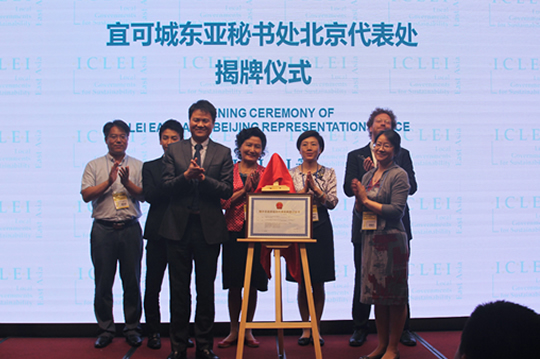
Accompanied by Partners and guests, Deputy Director General of BEPB Ruixian Wang
and Director of ICLEI East Asia Shu Zhu inaugurated the ICLEI Beijing Representation Office.
“Global practices have proven that GPP is an effective policy tool to trigger transition towards green production and consumption,” said Wang during her welcome speech for the opening of the workshop, “In fact, Beijing has introduced a comprehensive green procurement system into the municipality’s 2018 clean air action plan.”
“ICLEI has over 20 years of GPP implementation worldwide,” Shu Zhu introduced as he warmly welcomed the guests and participants, “through this workshop, we’ve invited experts from China, Germany, Japan, and the United Kingdom to share their knowledge and experiences on GPP with Chinese local governments.”
Yiqun Chen, Vice General Manager of CEC congratulated the success of the event, and on behalf of CEC, he presented the “Best Partner Plate” to Shu Zhu, Director of ICLEI East Asia as an appreciation of strong partnership between the two organizations.
Following the opening session, technical sessions started to provide in-depth knowledge and information on GPP to participants, including global and Chinese cases.
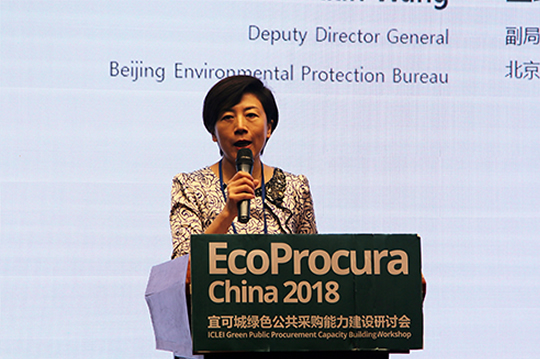
Ruixian Wang, Deputy Director General of Beijing Environmental Protection Bureau
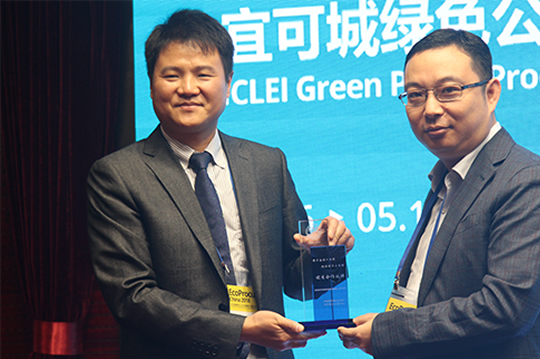
Yiqun Chen (right), on behalf of CEC, presented the “Best Partner Plate” to Shu Zhu of ICLEI East Asia.
Global Advanced Approaches to GPP
As advanced global approaches, Philipp Tepper of ICLEI’s Sustainable Procurement Center introduced ICLEI programs to build capacity and drive policy changes to accelerate green and sustainable procurement. Paula Walters from Public Health Wales shared the Procura+ award winning tender of reusing and remanufacturing as much already owned furniture as possible. In Asia, GPP implementation in Japan was presented by Hiroyuki Kobayashi, highlighting multilateral cooperation for GPP among national and local government, and non-profit organizations such as Eco Mark office and Green Purchasing Network as a success factor.
ICLEI: 20+ Years Experience in Sustainable and Innovation Procurement
“We create values through procurement.” said Philipp Tepper, Sustainable Economy and Procurement Coordinator of ICLEI’s Sustainable Procurement Center, “by doing it strategically and environmentally, we create enormous impact.” Through capacity building workshops, events, publications, and program/project implementation, ICLEI looks to create long-term cooperation on sustainable and innovation procurement. The Sustainable Procurement Center at ICLEI tracks development trend and influences policy changes on sustainable and green procurement through campaign and advocacy. The Procura+ Network (Europe) and the Global Lead City Network on Sustainable Procurement (GLCN) coordinated by ICLEI gather voices from local governments worldwide that are ambitious to achieve sustainable development goals through procurement, and foster international exchange.
Public Health Wales – Design of the Office Space and Supply of Office Furniture
Despite being unable to attend the workshop in person, Paula Walters, head of programme management office, Public Health Wales, the UK shared the award-winning sustainable procurement case “Design of the Office Space and Supply of Office Furniture for New Offices for Public Health Wales NHS Trust” through a video clip.
“This kind of project takes leadership and courage,” said Walters, “mangers need to get agreements upon staffs.” Nevertheless, the engagement with social enterprises exited politicians and the project was highly supported by the Wales Government. “We have applied for lots of awards. We did that consciously and with purpose.” Walters further explained the organization’s strategy, “We recognized when you start winning awards, people would want to talk to you. We have also got some data and could now talk to you about the project and spread the message.”
Green Public Procurement Local Practices in Japan
Hiroyuki Kobayashi, Chief of Promotion Section, the Japan Environment Association and Eco Mark Office, presented the Eco Mark project and GPP implementation in Japan. While the concept and practice of GPP was first introduced to Japan in 1989, it was not until 2000 that the “Act on Promoting Green Procurement” was enforced nationwide to encourage all sectors — private and public — to procure eco-friendly goods and services. According to Kobayashi, the lack of human resources and lower level of awareness and experiences among local governments are the main challenges of GPP implementation in Japan. Thus, the Japanese Ministry of Environment has been cooperating with the non-profit organization Green Purchasing Network (GPN) to promote green purchasing in Japan and support local governments in developing local procurement policy, manual, and training materials.
Legal Framework and System in China
In helping participants to better understand national legal framework for GPP in China, Government Procurement Specialist Xiaoming Wu, Yongmiao Yu from CEC, and Mingfei Luo from the China Quality Certification Center (CQC) gave overviews on the legal framework of government procurement, green supply chain, environmental labelled products and energy saving and low carbon certification for local sustainability in the Chinese context.
Shenzhen: GPP for Tackling Air Pollution
As an example of using GPP as a key tool to achieve broad policy goals, Jiansheng Li from Shenzhen Municipal Commission for Human Settlements and Environment introduced the green public procurement case for tackling air pollution in Shenzhen, with a focus on the phase-out of Ozone Depletions Substances (ODSs).
According to Li, under the Montreal Protocol on Substances that Deplete the Ozone Layer, the Chinese Government has taken strong actions to cut down the produce and use of ODS through ban on construction of new facilities that produce and consume ODSs; gradual close-down of existing production lines that produce and use ODSs; reduction on the export of products containing or made with ODSs; and steady decrease of ODSs production and consumption through green government procurement.
Through strategically forbidding and/or restricting the procurement of products that contain or consume ODSs (i.e. air conditioners, refrigerators, IT devices, fire extinguishers, medical equipment, etc.) by the government, it effectively reduced the consumption of ODSs in certain area, and encouraged producers and suppliers to seek for alternatives.
GPP Reality Check and Local Strategy
Before moving into implementation, Ling Ding from the CEC Green Procurement Promotion Office presented the current practice of GPP at local level in China. Five local governments of Beijing, Guangming New District, Urumqi Economic and Technological Development Zone (Totunhe District), Binhai New District, and Jizhou District also shared their local GPP practice and challenges, expressing their ambitions to go beyond the two government lists for GPP.
Participants continued to practice how to assess current situation and develop GPP targets and strategies by working in groups, moderated by Philipp Tepper of ICLEI.
GPP at the Local Level in China
According to Ding, the concept of green government procurement has been introduced and put into practice in China since 2006. In fact, through following the Environmental Labelling Government Procurement List and the Energy Conservation Product List issued by the national government, 90% of Chinese local governments have been implementing green government procurement. While much focuses have been placed on GPP of goods, the concept of GPP would be in included in construction projects for the 2020 Winter Olympic.
Reality Check for Implementing GPP
Through an interactive session moderated by Philipp Tepper of ICLEI, participants worked in groups to carry out SWOT analysis for implementing GPP at the local level. Most city representatives agreed strong local political support and ecological civilization being the national priority to be the most critical strength and opportunity of implementing GPP at the local level in China; whereas the lack of experience and comprehensive understanding of the concept appeared to be the major weaknesses of most participating jurisdictions, and the lack of assessment and evaluation mechanism has posed threat among the local governments in promoting GPP.
Participants also re-analyzed the environmental, economic and social development goals of their jurisdictions, and practiced drafting SMART (Specific – Measurable – Achievable – Relevant – Time-related) targets of GPP based on local needs.
GPP Implementation: Green Solutions and Best Practices
Identified by 10YFP SPP project cities, 4 products areas of furniture, construction, lighting and mobility were selected to explore best practices and solutions for GPP. Experts from CEC and CQC introduced how to utilize the Environmental Labelled Product List and the Energy Conservation Labelled Product List to procure green and energy efficient products under the Chinese national framework.
With the case of Yokohama, Eco Mark Office shared how Japanese local government develop their own criteria for furniture and institutionalize GPP practice in the administration system. ICLEI shared European best practices in mobility and lighting. Starting from common urban challenges, the cities of Rotterdam, Oslo and Copenhagen jointed the BuyZET project to explore innovative solutions for zero emission urban delivery of goods and services. The Transport for London implemented a successful tender process for the supply of energy efficient luminaries and lamps across the London Underground network by adopting pre-market consultation process and whole life cycle analysis.
In China, the program Green Supply Chain in the Real State Industry in China was launched in 2016 by SEE Foundation and its partners, to support real estate companies and suppliers to incorporate environmental assessment into their procurement processes and bid policies.
Furniture
People use furniture every day, be it for work, study, or for leisure. However, chemicals lurking in furniture and VOCs emitted by paints, varnishes and wood stains wreak indoor air pollution, and eventually have cumulative effect on human health and the environment. With 25% of furniture used around the world being made in China, efforts on environmental criteria and certification for green furniture have been made. For instance, a green supply chain evaluation for furniture, covering 30 categories and 130 items, has been developed by CEC.
“The production of green furniture requires comprehensive coordination of the entire supply chain.” said Xuefeng Ji, Senior Inspector of CEC, “Upstream companies are the foundation as they provide manufacturers environmental friendly raw and/or alternative materials, and facilities that meet environmental requirements.” The evaluation created by CEC focuses on 5 aspects of corporate environmental behavior assessment, management, design and development, supplier management, and raw material control. Up until 2018, 66 corporates have completed the evaluation and received green supply chain certification from CEC.
Weisen Pan from the APEC Cooperation Network on Green Supply Chain Tianjin Pilot Center (TGCC) explained how the Center promotes green procurement through green supply chain management. In particular, 6 GPP projects on furniture had been carried out in Tianjin, with around 30 businesses engaged in the bidding process.
On the other hand, in Japan, the city of Yokohama has also developed stringent criteria for the procurement of furniture. “In preventing the Sick House Syndrome, the 2003 Amendment of Building Standard Law was enforced by the Japanese Government to restrict materials concerning Formaldehyde, air ventilation and others,” said Hiroyuki Kobayashi, “but the city of Yokohama took a further step, introducing a more stringent requirement at the local level.” The city has set the ambitious goal of 100% GPP implementation, and has developed its own procurement criteria for local purpose, covering 23 categories and 277 items. Regarding implementation, the city has established an e-learning system to ensure officers are competent in GPP.
Construction
“Real estate and construction industries are producing 40% of the total carbon emission in China,” says Zhiyao Lu, Program Manager of SEE Foundation, “which is accountable for 8% of the global carbon emission.” SEE Foundation, together with its partners, launched the program Green Supply Chain in the Real Estate Industry in China in 2016 to promote green transition among steel, cement, aluminum alloy, and wood industries in the country through green procurement.
The market-driven program brings together real estate companies and suppliers to incorporate environmental assessment into their purchase and bid policies, with technical support provided by independent third parties. By 2018, 90 real estate companies representing sales revenue of 17% of the whole sector have joined the program, and over 200 upstream suppliers were engaged.
During this session, Dr. Hongjun Lee from the Center of Science and Technology for Construction, Ministry of Housing and Urban-Rural Development also explained the green building evaluation system at the national level to the local governments, and Philipp Tepper of ICLEI shared advanced practices in Finland and Germany to the participants.
Mobility
Lingsheng Tong of CQC presented the green vehicles certification the Center has been working on. Vehicle were included in the Energy Conservation Products (ECP) List for government procurement in 2010, and it was mandated that the amount of new energy vehicles purchased should account for no less than 10% of replaced municipal fleet of the year in 2014, and later on raised to 30% in 2016. In addition, Beijing, Shanghai, Anhui, and Jiangxi have included new energy vehicles into the product list of provincial government procurement.
In Europe, the project BuyZET coordinated by ICLEI is supporting cities to achieve zero emission urban delivery of goods and services through procurement of innovative solutions. The 5 participating cities would first identify the highest “transportation footprint” goods and services procurement areas in their cities, and prioritize two areas for further actions. Through the project, the cities could receive technical and financial support, and develop capacities via research, dialogue with stakeholders, and come up with innovative procurement for selected areas.
Lighting
Lighting consumes almost 20% of global electricity. Yet, with population growth and increased urbanization, it is projected by PHILIPS that the global lighting demand would increase 35% by 2030 compared to 2006. Thus, a transition towards energy-efficient and eco-friendly lighting could be a critical piece of global efforts to secure a low-carbon future.
Bonghee Son of ICLEI East Asia shared the Procura+ award winning case of “Innovative Lighting Procurement for London’s Underground Network” carried out by Transport of London. By adopting pre-market consultation process and whole life cycle analysis, the project replace the original system of Fluorescent lighting technologies with LED across the underground network covering 11 lines and 270 stations, and managed to significantly reduce the whole life cost, energy consumption, and GHG emissions.
“In China, 13% of electricity is used on lighting” said Min Gai, Certification Engineer of CQC, “and the demand is increasing.” In supporting the industry to move towards environmental friendly and energy efficient, CQC has developed a voluntary certification system, with 44 items under the CQC Certification (safety, electromagnetic compatibility and performance of lamps, lighting source and accessories), 20 items under the Energy Conservation Certification (efficiency of lamps, lighting source and accessories), and 2 items under China Labelling (eco-friendliness of lighting source).
While professional certifications could be helpful for local governments to make procurement decisions more easily, Gai also reminded city officers that it is important to ensure products are installed as instructed, and that they were identical as described in bidding proposals.
Procura+ East Asia network and way forward
The workshop was closed with the announcement of the launch of Procura+ East Asia network to support East Asian cities for GPP. ICLEI will continue to work together with cities in China and East Asian region to scale up green and sustainable procurement practice through GPP implementation projects, capacity building workshops and exchange programs under Procura+ East Asia.

